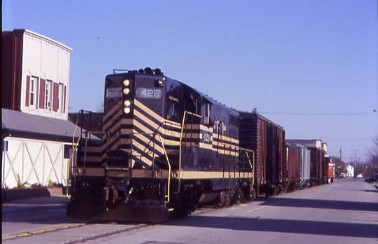
The sun poured in through the window! That meant the storm had left and we should have sunny skies for our last day in Indiana.
After a continental breakfast, Chris Parker and I drove north to leave the rental car at Tipton so we could get to the airport for the 5:20 PM flight for Chicago and then home.
The end of track at Tipton, Indiana. Dave Smetko and his son picked up Chris and I and drove us back to the Indiana Transportation Museum where we had some time to explore.
Indiana Transportation Museum HistoryThe Indiana Transportation Museum is an all-volunteer not-for-profit museum dedicated to preserving and showcasing railroads of Indiana, and sharing the equipment and information with the public, as well as operating trains to show how people travelled across the country in the past. Operating out of Forest Park in Noblesville, the Indiana Transportation Museum operated excursion trains on 38 miles of a former Nickel Plate Road line, originally built for the Indianapolis and Peru Railroad and travelled to the northern terminus of the line in Tipton and to the southern terminus at approximately 39th Street in Indianapolis. The rail line originally extended further south but had been abandoned.
The museum is home to many pieces of railroading history, with primary emphasis on locomotives and equipment relating to the Nickel Plate Railroad. Most passengers are carried in the museum's restored Budd cars that date back to 1937 and were originally in service on the Santa Fe Railroad and the New Jersey Transit Authority before being sold to the museum as scrap in the early 1980's. Several cars have been restored and others await funds for restoration.
The rail line originally connected to the Norfolk Southern railroad in Tipton and to the CSX railroad in Indianapolis via the Belt Line. The railroad line had also been operated as a freight railroad by the Indiana Rail Road, hauling coal to the power generating plant in Cicero, Indiana, until the plant's conversion to natural gas in 2003.
An unidentified Wabash caboose and Chesapeake & Ohio cupola caboose 90876 built in 1926.
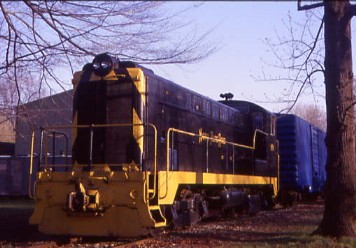
Nickel Plate Road VO-1000 99, nee United States Navy 9 assigned to Crane Naval Depot built by Baldwin Locomotive Works in 1945.
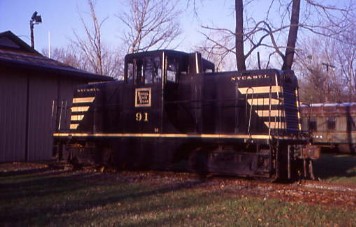
Nickel Plate Road 44 ton switcher 91, nee Boyne City Railroad 70 built by General Electric in 1950.
Indiana Transportation Museum GP9 200, ex. Central Railroad of Indianapolis 1755, exx. Great Smoky Mountains Railroad 200, nee Union Pacific 200 built by Electro-Motive Division in 1954. It was donated to the museum in 2000.
Indianapolis Street Railway Company Streetcar 153 built by the J.G. Brill Company in 1935 and operated until 1953. It was donated to the museum in 1972.
Nickel Plate Road F7A 83A nee Milwaukee Road 110C built by Electro-Motive Diivision in 1950 and purchased by the museum in 1982.
Indiana Transportation Museum rapid transit car 4293, ex. Chicago Transit Authority 4293 1947-1976, exx. Chicago Rapid Transit 4293 1924-1947, nee Chicago Elevated Railway 4293 1922-1924 built by Cincinnati Car Company in 1922.
When the Chicago elevated system was unified in 1913, design and construction of the system's first steel cars began. The result was several series of all-steel cars built with more modern trucks and electrical equipment than the older wood cars and designed with subway operation in mind. The early 4000's were built with all-steel roofs and no trolley poles and were nicknamed Baldies, but in the early 1920's more of the cars were built to a somewhat different design. Cars 4251-4455 were nicknamed Plushies due to their plush seats and had standard wood-and-canvas roofs and trolley poles. These cars operated across the Chicago rapid transit system for fifty years with few modifications. Around 1948, the CTA combined all of the 4000's into semi-permanently coupled pairs and rebuilt them for multiple unit door control, but except for these and a few other minor changes the cars that closed out the 4000 era on CTA in the 1970's were largely the same cars that had come from the factory fifty years earlier.
Car 4293 was one of several acquired by ITM (then called the Indiana Museum of Transportation and Communication) and was repainted in its original livery by that museum. By the late 1990's it was the only operational electric car at ITM, but around 1998 or 1999 it suffered a mechanical failure, thereby closing out the era of electric operation at Noblesville.
Monon FP7A 96, nee Milwaukee Road 96C built by Electro-Motive Division in 1951 and purchased by the museum in 1982, operating from 1983 to 1999.
Milwaukee Road F7B 68B built by Electro-Motive Division in 1950 and purchased by the museum in 1982 and was in storage for many years.
Indiana Transportation Museum rapid transit car 3328, ex. New Jersey Transit 4328 1983-1985, exx. Conrail 4328 1976-1983, exxx. Erie-Lackawanna 3328 1961-1976, exxxx. Delaware, Lackawanna and Western 2328 1930-1961, nee Delaware, Lackawanna & Western 676 1917-1930 built by Pullman in 1917.
Milwaukee Road SW-1 1613 built by Electro-Motive Division in 1939. It is used as a parts source for Monon SW-1 DS-50.
Museum scene.
Twin Branch Railroad steeple cab 4 built by Baldwin Locomotive Works/Westinghouse in 1929. Organized in 1927, the Twin Branch Railroad was less than two miles in length and hauled coal to the Indiana and Michigan Power Company's generating station on the St. Joseph River on the east side of the City of Mishawka.
Nickel Plate caboose 770 built by the railroad in 1954.
Passengers waiting for our photo freight to arrive at the platform.
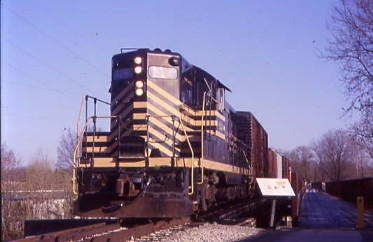
Our train arrived with GP7 426, Nickel Plate Road boxcar 8099, Conrail hopper 435140, Pennsylvania Railroad hopper 257784, Warren Petroleum tank car 3746, ITM boxcar 7, flat car B-38, Nickel Plate caboose 770, business car NKP 1, coaches 3076 and 3099 and Chicago, Burlington and Quincy combine 801 "Silver Salon".
Nickel Plate GP7 426. As soon as everyone was on board, we departed Forest Park station and went south, crossing Indiana Highway 19 then White River. Once across, we detrained for a unique series of photo runbys on the streets of Noblesville. Monon SW1 50 came to pull the passenger cars from the train so we would have just the freight train to photograph.
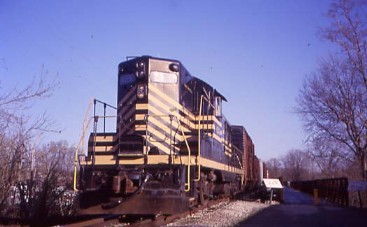
The train reversed to the White River bridge for static photos and we all walked to Conner Street, the main road through Noblesville.
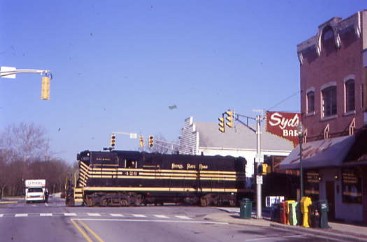
Crossing Conner Street. Our photo runbys would hold up traffic until the runby was complete.
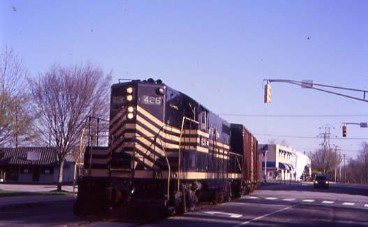
The train reversed to let traffic by before the photo runby.
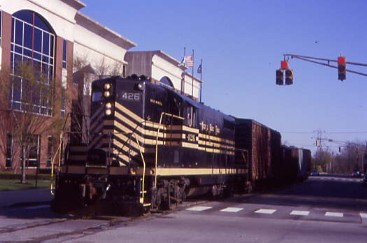
The next photo runby on Maple Street.
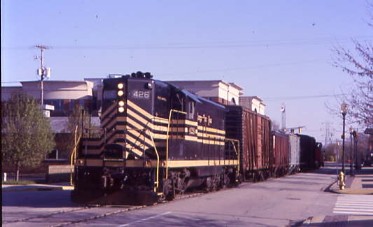
Another walk of a couple of blocks yielded this scene.
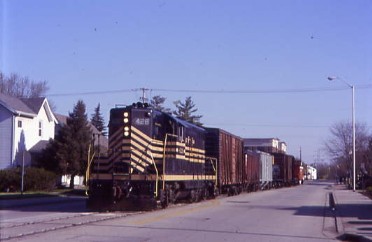
Keep walking, more pictures.

A final photo runby because the local police were wondering why traffic was so messed up on a Sunday morning.
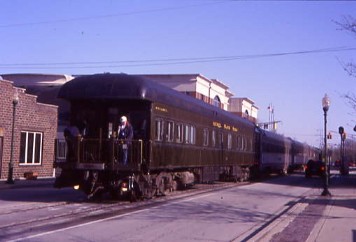
The passenger part of our train reversed down onto the freight set.
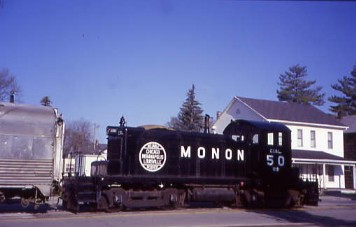
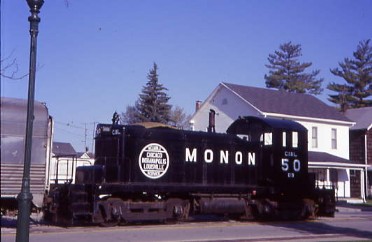
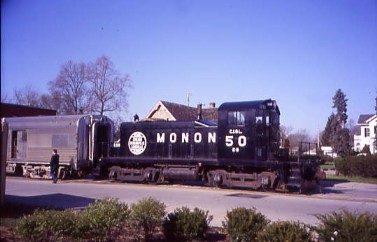
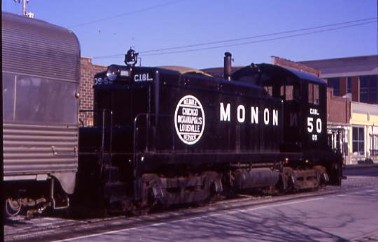
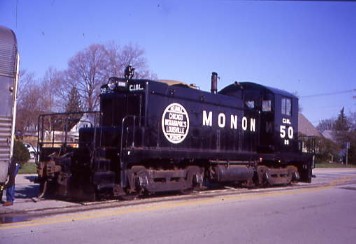
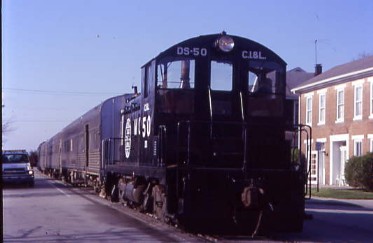
Indiana Transportation Museum SW-1 50, ex. United Electric Coal Company 50 1948, ex. Monon 1:2, nee Monon DS-50 built by Electro-Motive Division in 1942, was pushing the passenger set south. This locomotive was the first diesel engine for the Monon Railroad.
The locomotive pushed the passenger set south and coupled to our mixed train before it cut off. We all reboarded and I decided to explore the train and take interior photographs.
Interior of Nickel Plate Road business car 1 built by Pullman Company in 1929. From 1926 to 1936, it was used by Oris and Mantis VanSweringen, the owners of the Nickel Plate. The brothers were also the owners of the Chesapeake and Ohio, Pere Marquette and the Missouri Pacific. Prior to their entry into the railroad business, they developed Shaker Heights in Cleveland. They also built Terminal Tower, which is still a major landmark in downtown Cleveland.
In 1942, the car was sold to Chesapeake and Ohio as their Number 1, then returned to Nickel Plate as 1 in 1949. When the Norfolk and Western bought the Nickel Plate in 1964, it became N&W 1. In 1967, the car became N&W 103, which it remained until being retired in 1971. It was then sold to Henry Kegley, an industrialist in Bristol, Virginia, who preserved it on a siding at his paper mill, later Tenneva Foods, until his death in 1998. In 1999, it was purchased from Mr. Kegley's estate for use at the museum. After much volunteer effort, in May 2000, it moved by rail to the museum.
Indiana Transportation Museum coach 3096, nee Santa Fe 3096, built by Budd Company in 1937.
Indiana Transportation Museum coach 3099, nee Santa Fe 3099, built by Budd Company in 1937.
Indiana Transportation Museum combine 801 "Silver Salon", ex. Amtrak 1601 1975 [buffet and lounge configuration removed, 40 coach seats added and baggage section expanded), exx. Burlington Northern 801, nee Chicago, Burlington and Quincy baggage-lounge "Silver Salon" built by Budd Company in 1947. It was built for and served on the third version of the Twin Cities Zephyrs. As built, it had a 19 foot baggage section, a 14 foot buffet/bar section, and a 37 foot club lounge section with four tables.
On the way south, Nickel Plate Road 426 started smoking badly and it was decided to stop at Fishers where a crew from the museum would drive down to try and fix it. We arrived at Fishers for a long stop and all detrained.

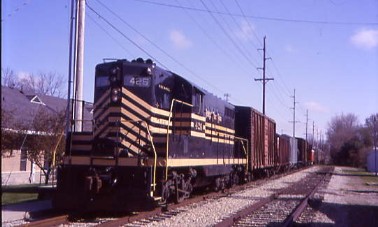
Front and rear views of our train.
The platform of Fishers station.
Our train at rest.
Bart Jennings had had all he could take as he laid down on the sidewalk taking a much-needed break. I walked to the Nickel Plate Café and bought a T-shirt as our engine was being fixed. It was then announced that we would have a photo runby in front of the café.

Nickel Plate Railroad 426 ran by the Nickel Plate Café.
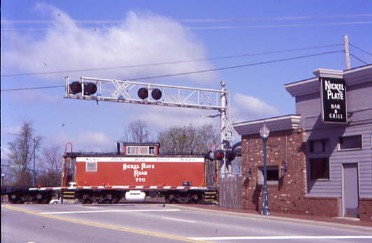
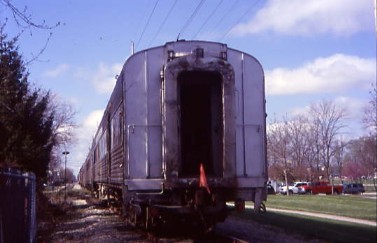
Nickel Plate caboose 770. Once the train had cleared the crossing, we all reboarded and continued south, passing through Castleton, going under Interstate 465 and Marlott Park before we passed the Indiana State fairgrounds where the museum runs trains when the fair is taking place. We crossed Fall Creek before approaching our turn-around point at 38th Street siding where we could detrain for pictures.
Our train had reached the southern end of our journey at the 38th Street Yard in the northern part of Indianapolis.
Nickel Plate caboose 770.
The engine then ran around our train and everyone reboarded. Bart walked through the train with new estimated arrival times for the museum, Tipton and the return. It had become so late that Chris Parker and I needed to get off at the museum and be driven back to our car at Tipton so we could make our flight. I told the crew of our problem and Joel Epstein, the brakeman, offered to drive us. While this would cut my trip mileage short, I could come back anytime and ride the pizza train to get that mileage. Bart said that the engine problem and running at only 10 mph caused our delays. It was decided once we returned to the museum that the freight cars would be cut off so the train could travel 25 mph. so we made our way back to the museum where several of us detrained.
Joel Epstein drove Chris Parker and I up to the car at Tipton.
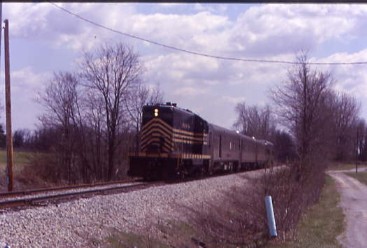
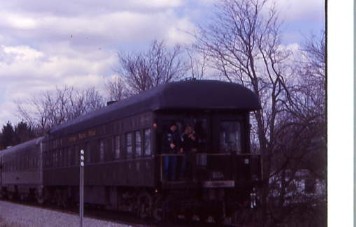
Coming back through Atlanta, Indiana, we spotted our train coming towards us and drove straight to the Indianapolis International Airport where we returned our Hertz rental car. A shuttle bus dropped Chris off at Northwest Airlines first where we shook hands and wished each other a safe flight home. Then the driver dropped me off at United Airlines and I used a touch screen to get my boarding pass and to check my two bags to Orange County. I went through security and was "puffed" as all the other passengers did; it was easy and quick. At 5:00 PM, they checked us in and we walked through the tunnel and downstairs to a waiting Embraer 145 airplane.
United Airlines 7781 operated by Chautauqua 4/15/2007We departed from Gate 9 at 5:25 PM EDT, then taxied out to be in position and took off at 5:34 PM EDT. It was a quick flight up to 20,000 feet before we descended through the clouds, arriving at Chicago O'Hare Airport at 5:19 PM CDT. I walked from Terminal B to Terminal C and had a ribeye steak sandwich at the Billy Goat Tavern and Grill then walked to Gate C11 where I wrote most of the Beech Grove story.
United Airlines 387 4/15/2007I boarded the B757 airplane at 8:00 PM CDT and took off at 8:27 PM CDT. I was tired but watched the movie and the NBC programs before an early arrival at Orange County at 10:25 PM PDT then was met by my mother and picked up my luggage before I drove us home, ending a fantastic trip to Pennsylvania and Indiana. A special thank you to Bart and Sarah Jennings for two days of photo trips over new mileage.
| RETURN TO THE MAIN PAGE |